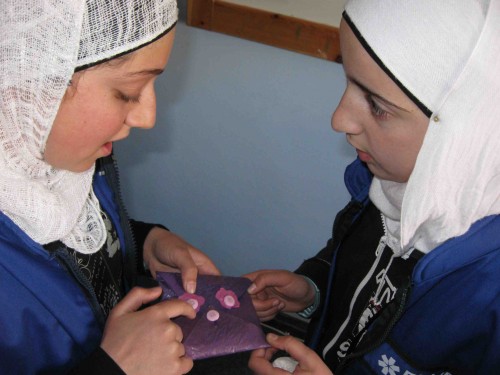Read more about Eric Pallant’s West Bank wanderings in his story about keynoting a green-building conference there.
There is a hamsin today, so the wind is whipping hot Saharan air and dust across the landscape. Despite the limited visibility, I can see that the cities that string south back from Ramallah, where I lectured at Birzeit University, to Jerusalem are well-kept and orderly. Palestinian military personnel stand in pairs every few miles. There is no trash in the street or in yards. Tall apartment buildings are tidy; no laundry is hanging from windows the way it does in Israeli tenements. Billboards advertise state banks and Coca Cola.
My afternoon will be given over to the Faisel Husseini Foundation for Educational Improvement, located in the heart of the Old City of Jerusalem. Once we arrive, we enter the famous Old City walls through the Damascus Gate into the Arab Quarter, winding our way past vegetable sellers hollering the names of produce and extolling the quality of their chickpeas, tomatoes, and grape leaves. Walking deeper inside the market, past the clothes boutiques and spice and sweets sellers, we make a left in an alleyway and ascend several flights of limestone stairs.
 At work on a new kind of craft.Eric PallantI have been brought to help teachers with no environmental training understand the value of reduce, reuse, recycle. I do my usual spiel about how I barely care about solid waste and landfills, but am concerned instead about the energy and water required to make and transport a product in the first place. My audience is three Christian Armenian women, six covered and scarved Arab women, and one man with the mark of praying to Mohammed bruised into his forehead.
At work on a new kind of craft.Eric PallantI have been brought to help teachers with no environmental training understand the value of reduce, reuse, recycle. I do my usual spiel about how I barely care about solid waste and landfills, but am concerned instead about the energy and water required to make and transport a product in the first place. My audience is three Christian Armenian women, six covered and scarved Arab women, and one man with the mark of praying to Mohammed bruised into his forehead.
In two hours I show them how to make paper, turn used fryer oil into biodiesel (methanol, caustic soda, and olive oil that has fried too many falafels), and create fused plastic-bag fabric. This plastic-bag fabric is proving to be a big hit on the West Bank. If there is an international fruit in the developing world, it is the plastic bag. So ubiquitous are they that in many countries I have visited, these inexpensive, flimsy bags are speared on branches like apples in an abundant year.
I had arrived with plans for taking an iron and melting together eight layers of bags. My plan was to demonstrate how to create the fabric, hope someone in the room could sew better than I can, and have the teachers begin to teach their students to make recycled shopping bags. I dream — or as they say in Arabic about virtually anything worth hoping for in the future, Inshallah (literally, it will be God’s will) — that the fashion in five years will be like it is at Target. Show up with your own bag, eschew the inadequate one they give you, and even wash yours out if it gets messy. It’s only plastic, after all.
 I am not a plastic bag.Eric PallantBut like the college students at Al Quds, at Faisel Husseini these women began designing things I had no idea were possible. They mix different colored bags to design multihued flowers and then fuse their flowers onto latchable purses. They make gardening gloves, wall hangings for children, and religiously adorned shoulder bags. There are picture frames and jeweled tissue dispensers, little heart-shaped diaries, and ornate appliqué florets sewn onto cloth bags. All this in under two hours per group.
I am not a plastic bag.Eric PallantBut like the college students at Al Quds, at Faisel Husseini these women began designing things I had no idea were possible. They mix different colored bags to design multihued flowers and then fuse their flowers onto latchable purses. They make gardening gloves, wall hangings for children, and religiously adorned shoulder bags. There are picture frames and jeweled tissue dispensers, little heart-shaped diaries, and ornate appliqué florets sewn onto cloth bags. All this in under two hours per group.
I had mentioned to the teachers that they could finish the edges with discarded fabric from worn-out clothing or the famous red and black embroidery worn by many Palestinian women, but it is clear from the intensity of their eyes as they cut, iron, sew, and gossip that my suggestions are not going to be needed. Fusing plastic on the West Bank has legs.



